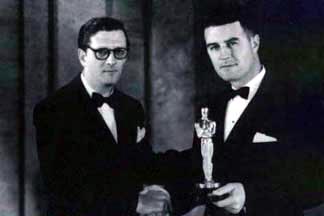Douglas
Shearer
Originating
Sound for Film 1899-1971
Douglas Shearer,
a pioneer of motion picture sound, was born in Montreal in 1899. He left
high school early, worked as a machinist, travelled for an industrial power
plant, and learned signalling, photography, and flying.
At age 26 he journeyed
to Hollywood not long after his actress-sister Norma joined Metro-Goldwyn-Mayer
studio. He and Norma improved a system linking actors’ voices, broadcast
over radio, with a theatre screen, and his “movieola” used punch holes
to indicate spoken words on strips of paper.
Jack Warner invited
him to Warner Brothers studio where he worked in props but in 1927 he returned
to MGM as an assistant cameraman. When Norma married studio boss Irving
Thalberg, Douglas championed talking pictures, even to Louis B. Mayer.
As its competitors moved to sound, MGM enlisted Shearer’s assistance. “No
longer were disks going to be used,” he recalled in 1970. “Instead it was
going to be done with a couple of ribbons that oscillated and a beam regulating
the amount of light that reached the film, which, in turn, produced the
sound change. So off I went to Bell Labs and learned about sound.”
Shearer and a crew
that he “stole from every which where” gave the famous MGM lion an audible
roar and added sound (a thief cracking a safe) and dialogue to Alias Jimmy
Valentine. They put music to film “in a church auditorium of the Victor
Phonograph Company in Camden, New Jersey” and a music track on the documentary,
White Shadows in the South Seas. Their work culminated in MGM’s first musical,
The Broadway Melody, which was named best picture of 1928-29 by the new
Academy of Motion Picture Arts and Sciences.
 |
| Douglas
Shearer won the first Academy Award for sound recording for The Big House,
1930. Born in Montreal, the older brother of Norma Shearer also devised
Tarzan’s famous electronic yell and solved the problem of Jeanette MacDonald’s
tendency to go flat on her high notes by adjusting the soundtrack frame
by frame and “retouching” her voice. By the time he retired in 1968, he
had won a total of seven Academy Awards. He also won an additional seven
Academy citations for scientific and technological advances within the
movie industry. In all, Douglas Shearer was nominated for 20 Oscars and
his screen credits total some 1,400. This photo shows Douglas Shearer,
on the right, at the 1935 Academy Awards dinner, March 1936, holding the
award for sound recording for Naughty Marietta from presenter Hunt Stromberg.
[Photo, courtesy Academy of Motion Picture Arts and Sciences via National
Film Information Services] |
At MGM’s studio in
Culver City, just outside Hollywood – where John Arnold ran the photography
department, art director Cedric Gibbons reshaped the MGM backlots, and
Thalberg “always wanted to know what was going on with the sound, costumes
and photography” – Shearer set up and ran the sound department and recorded
films. He accepted the first Academy Award given for sound for The Big
House (1930) and worked on films that earned Oscars for Norma Shearer in
The Divorcee (1930) and for Canadian-born actress Marie Dressler in Min
and Bill (1931). He created the famous yell for Tarzan the Ape Man and
took equipment up in his own plane to get realistic sound for Night Flight.
And he recorded the films that brought Thalberg best-picture Oscars – Grand
Hotel (1931-32) and Mutiny on the Bounty (1935).
His proudest accomplishment
did away with the sound distortion troubling the MGM-controlled Loew’s
theatres. The two-element “Shearer horn” – tried out first at Loew’s theatres
in Montreal and New York in 1936, and used at the opening of Romeo and
Juliet (Thalberg’s last completed production involving both Shearers) –
helped earn Douglas Shearer and the MGM sound department a scientific/technical
award from the Academy’s Board of Governors.
For improving the
production and projection of motion picture sound and photography, Shearer
and colleagues received six other scientific/technical awards. The first
was for 1935 and the last for 1963, including one for 1959 for developing
a method for producing and exhibiting 65-mm film which was used in MGM’s
film, Ben Hur, which swept the Oscars that year. For his work on individual
films (some 1,400 in all, he estimated) Shearer received 20 Oscar nominations
and accepted 7 Academy Awards (the last one for 1951) by the time he retired
in 1968.
Shearer died in 1971
in Culver City. He had worked with many of the most able people in motion
picture arts and sciences and earned enormous respect for his work that
helped shape movie sound and photography worldwide.
John
Parry

